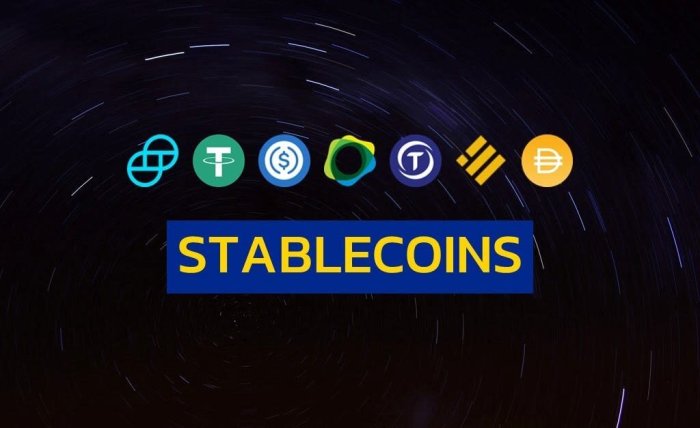Understanding Stablecoins in the Crypto World introduces readers to the fascinating realm of digital currencies, shedding light on the innovative concept of stablecoins and their impact on the evolving crypto landscape. From their unique pegging mechanisms to their crucial role in the market ecosystem, this exploration promises to be both informative and captivating.
As we delve deeper into the various types, benefits, risks, and regulatory aspects of stablecoins, a clearer picture emerges of how these digital assets are shaping the future of finance and revolutionizing the way we perceive monetary transactions.
Introduction to Stablecoins

Stablecoins are a type of cryptocurrency that are designed to minimize the price volatility typically associated with other digital assets like Bitcoin or Ethereum. These coins are pegged to a stable asset, such as a fiat currency like the US Dollar or commodities like gold, in order to maintain a steady value.
Popular Stablecoins and Pegging Mechanisms
Stablecoins come in various forms, but some of the most popular examples include Tether (USDT), USD Coin (USDC), and DAI. Each stablecoin uses different mechanisms to maintain its peg to the underlying asset. For instance, Tether claims to be backed 1:1 by US Dollars held in reserve, while DAI relies on overcollateralization of Ethereum assets to stabilize its value.
Importance of Stablecoins in the Crypto Market Ecosystem
Stablecoins play a crucial role in the cryptocurrency market by providing a reliable medium of exchange and store of value. Traders often use stablecoins to hedge against market volatility or quickly move funds between different exchanges. Additionally, stablecoins allow users to participate in decentralized finance (DeFi) applications without being exposed to the price fluctuations of other cryptocurrencies.
Types of Stablecoins

Stablecoins come in various types, each with its own unique stability mechanisms and use cases. Let’s dive into the different types of stablecoins to understand how they work in the crypto world.
Fiat-Collateralized Stablecoins
Fiat-collateralized stablecoins are backed by reserves of fiat currency such as USD or EUR. These stablecoins maintain a 1:1 peg to the fiat currency they are backed by, providing stability. The reserves are held in a custodian bank and audited regularly to ensure transparency and trust.
Crypto-Collateralized Stablecoins
Crypto-collateralized stablecoins are backed by other cryptocurrencies like Ethereum or Bitcoin. These stablecoins use overcollateralization to maintain their peg to a fiat currency. Smart contracts ensure the stability by automatically liquidating collateral if the value drops below a certain threshold.
Algorithmic Stablecoins
Algorithmic stablecoins rely on algorithmic mechanisms to maintain stability without collateral backing. These stablecoins use algorithms to adjust the coin supply based on demand in the market. The goal is to stabilize the price through supply and demand dynamics.
Hybrid Stablecoins, Understanding Stablecoins in the Crypto World
Hybrid stablecoins combine elements of both fiat and crypto collateralization, as well as algorithmic mechanisms. These stablecoins aim to leverage the strengths of different types to achieve a more stable and resilient stablecoin. They may use a combination of reserves, crypto collateral, and algorithmic adjustments to maintain stability.
Each type of stablecoin serves different use cases depending on the needs of users. Fiat-collateralized stablecoins are often used for remittances and everyday transactions due to their stability. Crypto-collateralized stablecoins are popular among crypto traders for hedging against volatility. Algorithmic stablecoins provide an alternative to traditional stablecoins, offering stability without relying on physical assets. Hybrid stablecoins combine the best of both worlds, providing a balanced approach to stability in the crypto world.
Benefits and Risks of Stablecoins: Understanding Stablecoins In The Crypto World
Stablecoins offer a variety of benefits and risks that are important to consider in the crypto world.
Advantages of Stablecoins
- Reduced Volatility: Stablecoins are designed to minimize price fluctuations, providing a stable store of value compared to other cryptocurrencies.
- Faster Transactions: With stablecoins, transactions can be processed quickly and efficiently, allowing for seamless transfers of value.
- Global Accessibility: Stablecoins enable users to access digital assets regardless of geographical location, promoting financial inclusion on a global scale.
Risks Associated with Stablecoins
- Regulatory Challenges: Stablecoins may face regulatory scrutiny due to concerns about money laundering, compliance, and financial stability.
- Centralization Issues: Some stablecoins are centralized, which can pose risks related to control, security, and transparency.
- Counterparty Risks: Depending on the type of stablecoin, users may be exposed to counterparty risk if the issuer fails to maintain proper reserves or collateral.
Contribution to Financial Inclusion and Innovation
Stablecoins play a crucial role in expanding financial inclusion by providing individuals with access to digital assets, especially in regions where traditional banking services are limited. Additionally, stablecoins drive innovation in the fintech sector by introducing new ways to transact, invest, and store value, ultimately reshaping the future of finance.
Stablecoin Regulation

In the world of cryptocurrencies, stablecoins have gained popularity for their ability to maintain a stable value compared to the volatile nature of other digital assets. However, with the rise in the use of stablecoins, regulatory authorities around the globe have started to pay closer attention to this sector.
The regulatory landscape for stablecoins varies significantly from one country to another. While some countries have embraced stablecoins and provided clear guidelines for their issuance and use, others have taken a more cautious approach, raising concerns about potential risks associated with these digital assets.
Global Regulatory Approaches
- United States: The United States has taken a proactive approach towards regulating stablecoins, with the Securities and Exchange Commission (SEC) and the Commodity Futures Trading Commission (CFTC) playing key roles in overseeing these digital assets.
- European Union: In the EU, stablecoin regulation is still in the early stages, with the European Central Bank (ECB) and the European Securities and Markets Authority (ESMA) monitoring the development of stablecoins and their potential impact on financial stability.
- Asia: Countries like Japan and Singapore have been more welcoming towards stablecoins, with regulatory bodies in these regions working towards creating a conducive environment for the growth of stablecoin projects.
Impact of Regulation
Regulatory measures can have a significant impact on the adoption and development of stablecoins. Clear guidelines and regulations can provide investors and users with a sense of security, boosting confidence in these digital assets. On the other hand, overly restrictive regulations may stifle innovation and hinder the growth of the stablecoin market.

